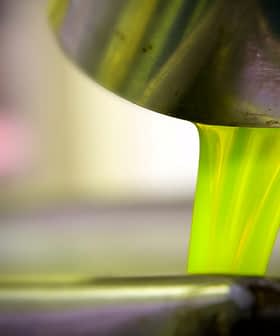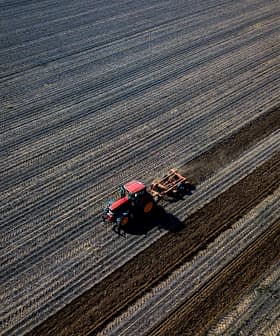
Don’t be confused by the name. Berkeley Olive Grove 1913 extra virgin olive oil originates hundreds of miles from the East Bay’s iconic gourmet ghetto streets. That’s not to say that there isn’t a connection — an academic link that turned educators into businessmen at the turn of the century. The area around Oroville, California, attracted the attention of several members of the University of California when reports were published between 1900 and 1904 regarding the region’s exemplary olive-growing climate. In 1913, as many as 15 professors individually invested in some land and, within the course of their lifetime, managed the largest planting of Mission olive trees in the world.
Today you can still find this pristine piece of land producing Mission olives, its stately trees providing a protective habitat for a thriving ecosystem. Being good stewards to this abandoned piece of land was Darro and Olivia Grieco’s primary intent when they heard it was bank-owned and available. “Initially, I wasn’t thinking about olive oil, but conserving and bringing the land back to its glory,” says Darro Grieco. Within two years Grieco was producing award-winning extra virgin olive oil from this hundred-year-old grove under the name Berkeley Olive Grove 1913.
With an average lifespan of 600 years, the olive trees that occupy the Grieco’s grove are just hitting their stride. These Mission olive trees, set out over 400 acres, are the only olive variety indigenous to the Americas. Brought to the United States by Franciscan monks and planted at each of California’s 21 missions, the Mission olive and its oil served many purposes from culinary, medicinal, ceremonial, to industrial. The Mission olive is also one of the few varieties that can cross over from table to oil. Leave it to Grieco and his insatiable interest in this variety’s oil capabilities to master the subtleties of extra virgin olive oil making in such a short period of time.
As a dry-farmed, certified organic, sustainable grove, Grieco is at the mercy of the weather and the challenges of organic farming. He’s learned to adapt to the fickleness of nature while implementing changes that don’t disrupt the cycle. ” I have the added responsibility of stewarding the land while further developing the productivity of the orchard,” says Grieco. One such change has been to prune limbs to open the trees’ canopy, which has increased production and extended the harvest.
The farm sharply contrasts with the trend toward high-density groves and mechanical harvesting championed by producers in this area and other New World producing regions like Australia and Chile. And while producers are increasingly engaged in learning modern techniques to increase efficiencies and profitability, the Griecos like their low-density, low-tech farm just fine.
From his first bottling in the spring of 2008, Grieco’s extra virgin olive oil has been receiving awards from national and international judges. Most recently his California Mission ‘Gold’ won Best in Show at the Los Angeles International Extra Virgin Olive Oil Competition. Grieco’s aim was to create a perfect balance of the values judges look for.
Each of the three award-winning Mission extra virgin blends that Grieco bottles, ‘California Mission Gold’, ‘California Mission Classic’, and ‘California Mission Reserve’ are high in polyphenols. Grieco believes there’s a direct correlation between high polyphenols and dry farming. “The same principles in wine can be applied to olives in regards to dry farming. An intensity develops due to the stress that is put on the olive, resulting in higher levels of polyphenols”, says Grieco. Extra virgin olive oils tested in a recent UC Davis study had an average polyphenol level of 199 parts per million, Grieco points out. The polyphenol levels in his oils range from 317 to 425 ppm. These high levels, along with an excellent sensory profile, make Grieco’s extra virgin firmly on par with oils classified as super-premium extra virgin olive oil.
Berkeley Olive Grove 1913 EVOO has acidity and polyphenol levels displayed right on the bottle. As far as he knows, Grieco is the only producer to provide this information on packaging. “This helps people understand and ask about the values of extra virgin olive oil”, says Grieco. Though this lab work is an added expense, he feels it’s worth it to educate the consumer and differentiate his extra virgin olive oil from others.

Naturally, Mission olives have higher levels of polyphenols, but the levels decrease as the fruit ripens. Late harvest Mission olive oil is known for mellow buttery notes, but at this stage of ripening, polyphenol levels have considerably decreased. Grieco harvests several times throughout the season and blends his harvests to maximize both flavor and polyphenol levels. How he mills each harvest also has an effect on the final result.
 Based on tasting notes from his website, California Mission Gold is bright with a medium green grass nose and light mint and herbaceous notes on a medium soft buttery base. California Mission Classic is bright with a pine nose and interesting accents of rose, almond, and green grass over a medium buttery base. California Mission Reserve has a more delicate taste that is easy to like with notes of ripe apple and a hint of mint on a warm nutty base.
Based on tasting notes from his website, California Mission Gold is bright with a medium green grass nose and light mint and herbaceous notes on a medium soft buttery base. California Mission Classic is bright with a pine nose and interesting accents of rose, almond, and green grass over a medium buttery base. California Mission Reserve has a more delicate taste that is easy to like with notes of ripe apple and a hint of mint on a warm nutty base.
The Griecos plan to allow people to visit this historic and important part of California history. The site will soon host a visitor center and venues for private events and seminars where visitors can observe how a traditional olive grove is managed. With hand pruning, hand harvesting, and traditional milling techniques, Berkeley Olive Grove 1913 is demonstrating that the future of this ultra-premium extra virgin olive oil depends on the traditions of olive farming and oil making established centuries ago.
Visit Berkeley Olive Grove 1913 online to purchase extra virgin olive oils and learn more.








